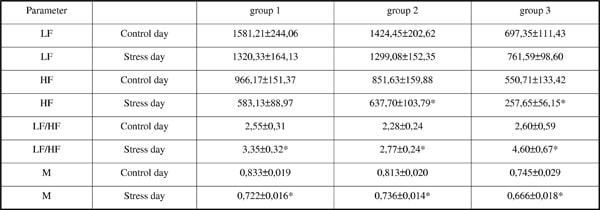The purpose of this study was to investigate the effects of subjects personality on heart rate variability (HRV) when stress was induced by examination. 105 healthy female students with a mean age of 21.51±0.09 years volunteered for the experiment. To study the role of probabilistic forecasting of results in the development of the real life stress affect on the heart rate control, each student was asked to predict her mark. Groups were formed based on the difference between the expectations and the actual mark (group 1: expectation = actual mark; group 2: expectation > actual mark; group 3: expectation < actual mark) [2]. HRV was recorded after 10-minute supine rest for 5 minutes while subjects were resting in a supine position [1]. The students were examined in the following sequence: recording of HRV at rest and shortly before real life stress. The values were compared by Mann-Whitney test (U) and sign test (Z). Mean values of M, LF, HF and LF/HF for the different groups are presented in Table 1. In the present study significant differences during control day were observed in M between group 2 and group 3 (U=265.50; p=0.03) in LF between groups 1 and 3 (U=194.00; p=0.01) and between groups 2 and 3 (U=243.00; p=0.02). The M was significantly higher in group 1 than in group 3 (U=186.00; p=0.007) during stress day. Significant differences during stress day were observed in LF between groups 1 and 3 (U=206.00; p=0.02), in HF between groups 1 and 3 (U=169.00; p=0.003) and between groups 2 and 3 (U=254.50; p=0.02), in LF/HF between groups 1 and 3 (U=203.00; p=0.02). The differences in LF/HF were significantly larger between groups 1 and 3 (U=207.00; p=0.02) and between groups 2 and 3 (U=276.00; p=0.04). The main finding of this study on healthy young subjects is that a mild real life stressor, is capable to produce complex changes in major cardiovascular regulatory mechanisms. This result also suggests that susceptibility to stress would presumably be different from person to person and be affected by probabilistic forecasting of results.
Life Sciences 2007 (2007) Proc Life Sciences, PC333
Poster Communications: The effects of subjects personality on heart rate variability during stress
D. A. Dimitriev1, E. V. Saperova1, Y. D. Karpenko1
1. The Department of Biology and Chemistry, Chuvash State Teacher's Training University named after I.Y.Yakovlev, Cheboksary, Chuvash Republik, Russian Federation.
View other abstracts by:
Table 1. Descriptive Statistics of RR Interval Variabilities in Healthy Subjects During Stress and Control Days
Where applicable, experiments conform with Society ethical requirements.

